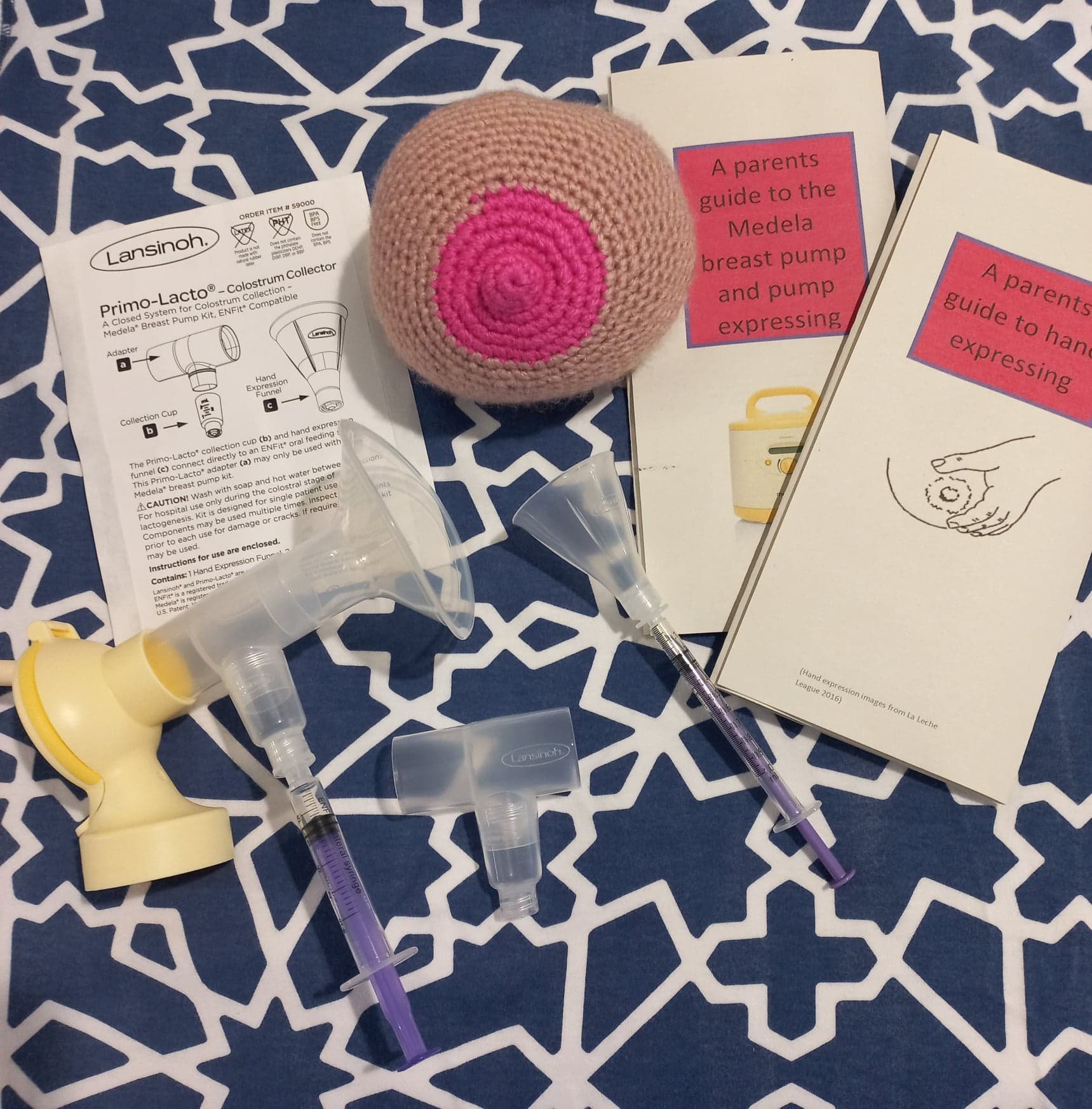Liquid Gold: How Colostrum Saves Money
Drawn by Jules Sherman “Sasha’s Dream”
Sasha had given birth to preterm twins at 30 weeks. She was instructed to pump and hand-express her colostrum into a bottle or medicine cup. It was awkward to use the breast pump because the colostrum got stuck in the valve of the pump, and nurses had to scrape it out. After using the medicine cup for hand-expression, nurses sucked the colostrum up with a syringe. Sasha was able to collect enough colostrum to supply her babies with the important antibodies and nutrients to help them grow, but the experience was awkward, slow and made her anxious.
Rates of preterm delivery remain high, and in several developed countries continue to increase, because of changing demographic factors (such as maternal age, rates of twinning and assisted conception). Combined with the explosion of interest in developmental programming, studies continue to demonstrate the importance of nutrition and growth in early life. (1,2)
The colostrum of mothers delivering preterm is especially rich in non-nutritive immune-protective components compared with mature breast milk. In preterm infants colostrum may facilitate immunological maturation. (3) Furthermore, formula-fed infants, have a higher rate of feed intolerance and a doubling of the risk of NEC. (4) Further research is needed to investigate the effects on neurodevelopment.
Recent work has shown that mixing of milk and the neonate’s saliva appears to represent a unique biochemical synergism that may boost early innate immunity.(5) Breast milk feeding is associated with an altered oral and nasopharyngeal microbiota later in infancy. (5) However, oral feeding is not practical in most preterm infants owing to developmental immaturity. Recently, the practice of early (as soon as produced by the mother) oral administration of mother’s own colostrum was proposed as a protective strategy. Similar to breast feeding in term infants, recent studies have shown that oral colostrum priming (OCP) may influence the microbial colonization of the oral cavity in very low birth weight infants (o1500 g), decrease clinical sepsis, inhibit secretion of proinflammatory cytokines, increase levels of circulating immunoprotective factors inextremely preterm infants (o28 weeks) and increase weight at 36 weeks corrected age.(6)
While neonatal ICU patients account for approximately 0.15 percent of the U.S. population, they account for about 0.45 percent of the total health care costs. The average cost for infants hospitalized in neonatal intensive care units is around $3,000 per day. While the average cost to an employer of a healthy baby born at full-term, or 40 weeks of gestation, is $2,830, the average cost for a premature baby is $41,610. If the baby is born at 26 weeks, the cost can quickly rise to $250,000 or more. (7)
Studies show that A 16-day reduction in median length of hospitalization was noted for the infants who received oral colostrum priming as compared with infants who did not. (5) That’s a $48K savings. In other words, (I’m talking to you insurance companies and employers) a mother’s colostrum is quite literally “liquid gold”. In fact, if I were an insurance company president, I would pay mothers as an incentive to express their colostrum.
Dorchester Special Care Baby Unit posted this photo of Primo-Lacto® on facebook.
Maternal Life LLC is on a mission to make colostrum collection easier for moms. Primo-Lacto® is a closed system for colostrum collection and feeding. Primo-Lacto® should be used when a mother is separated from her infant at birth due to prematurity or other health issue which prevents her from breastfeeding directly the first 1-3 days post birth during the colostral phase of lactogenesis. Primo-Lacto® is a two-part system composed of a breast pump adapter and hand expression funnel. The concept is based on Dr. William Rhine’s and Dr. Jane Morton’s research at Stanford University (8) which defined best practice for colostrum collection. Combining both hand expression and pump expression yields more colostrum, higher caloric value colostrum and less pain for mom. Primo-Lacto® could help 1M mothers and babies annually in the US have healthier babies, enjoy earlier discharge and avoid unnecessary anxiety about breastfeeding. Primo-Lacto® is a dedicated device for helping mothers provide their baby with the nutrition they deserve. Primo-Lacto® was funded by The New England Pediatric Device Consortium and the National Capital Consortium For Pediatric Surgical Innovation (NCC-PDI Award). Purchase here (hospital volume orders have tiered discounts).
At the time this article was written I was a researcher and product designer for Stanford’s School of Medicine, Pediatrics Dept. and the Founder/CEO of Maternal Life LLC. Lansinoh acquired Primo-Lacto® in 2018.
References:
1. Koletzko B, Poindexter B, Uauy R. Nutritional Care of Preterm Infants. Scientific Basis and Practical Guidelines. 1st ed. Koletzko B, Poindexter B, Uauy R. editor. Switzerland: S. Karger AG; 2014.
2. Agostoni C, Buonocore G, Carnielli VP, et al. Enteral nutrient supply forpreterm infants: commentary from the European Society of Paediatric Gastroenterology, Hepatology and Nutrition Committee on Nutrition. J Pediatric Gastroenterol Nutrition 2010; 50:85–91.
3. Gephart SM, Weller M. Colostrum as oral immune therapy to promote neonatal health. Adv Neonatal Care 2014; 14:44–51.
4. Embleton ND, Morgan C, King C. Balancing the risks and benefits of parenteral nutrition for preterm infants: can we define the optimal composition? Arch Dis Child Fetal Neonatal Ed 2015; 100:F72–F75
5. J Romano-Keeler1, MA Azcarate-Peril2, J-H Weitkamp1, JC Slaughter3, WH McDonald4, S Meng1, MS Latuga5 and JL Wynn6 Oral colostrum priming shortens hospitalization without changing the immunomicrobial milieu. Journal of Perinatology (2017) 37, 36–41; doi:10.1038/jp.2016.161; published online 29 September 2016
6. Maron JL, Hwang JS, Pathak S, Ruthazer R, Russell RL, Alterovitz G. Computational gene expression modeling identifies salivary biomarker analysis that predict oralfeeding readiness in the newborn. J Pediatr 2015; 166(2): 282–288.e285.
7. https://www.managedcaremag.com/archives/2010/1/how-plans-can-improve-outcomes-and-cut-costs-preterm-infant-care
8. Combining hand techniques with electric pumping increases milk production in mothers of preterm infants. J. Morton, JY Hall, RJ Wong, L. Thairu, WE Benitz, and WD Rhine. Department of Pediatrics, Stanford University School of Medicine, Stanford, CA USA
Comments are closed.


